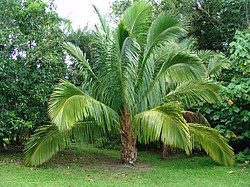| Beccariophoenix | |
|---|---|
 | |
| A young Beccariophoenix palm. | |
| Scientific classification | |
| Kingdom: | Plantae |
| Clade: | Tracheophytes |
| Clade: | Angiosperms |
| Clade: | Monocots |
| Clade: | Commelinids |
| Order: | Arecales |
| Family: | Arecaceae |
| Subfamily: | Arecoideae |
| Tribe: | Cocoseae |
| Subtribe: | Attaleinae |
| Genus: | Beccariophoenix Jum. & H.Perrier |
| Type species | |
| Beccariophoenix madagascariensis | |
Beccariophoenix is a genus of three species of Arecaceae (palms), native to Madagascar. The genus is closely related to the Cocos , or coconut genus, and notably Beccariophoenix alfredii is similar in appearance to the coconut palm. It was named after Odoardo Beccari (1843-1920).


